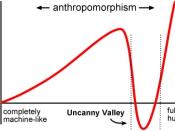The uncanny is the subject of aesthetics because it has to do with a certain kind of feeling or sensation with emotional impulses. But in general aesthetics has neglected to study the uncanny, preferring to concentrate on beauty and generally on more positive emotions such as: the attractive, the sublime...etc. The uncanny is something fearful and frightening, and such as it has been neglected in the history of aesthetics. Freud will wed psychoanalytic and aesthetics modes of thought to develop his theory of the uncanny.
What is the uncanny?
Freud's definition = uncanny as the class of frightening things that leads us back to what is known and familiar.
Jentsch's conclusions:
1)Uncanny = fear of the unfamiliar
2)Uncanny = based on intellectual uncertainty
Freud will take issue with both of these cases.
The study of the German words, heimlich and unheimlich (homely/ unhomely)
Freud defines heimlich in two different meanings:
1)Heimlich = (a) belonging to the house, friendly, familiar, (b) tame (as in animals), (c) intimate, comfortable.
(a)Belonging to the house or family, or regarded as so belonging.
(b)Of animals: tame, companionable to man as opposed to wild. For example, 'Animals which are neither wild nor heimlich'
(c)Intimate, comfortable; the enjoyment of quiet content, arousing a sense of agreeable restfulness and security as in one within the four walls of his house 'Is it still heimlich to you in your country where strangers are felling your woods?' Many examples are applied on page (932).
2)Heimlich = concealed, secret, withheld from sight and from others; secretive, private. For example, to do something heimlich behind someone's back; to steal away heimlich; heimlich meetings and appointments...etc. Many examples are applied on page (933).
What from the perspective of the one who is "at home" is familiar, is to the outsider, the...


